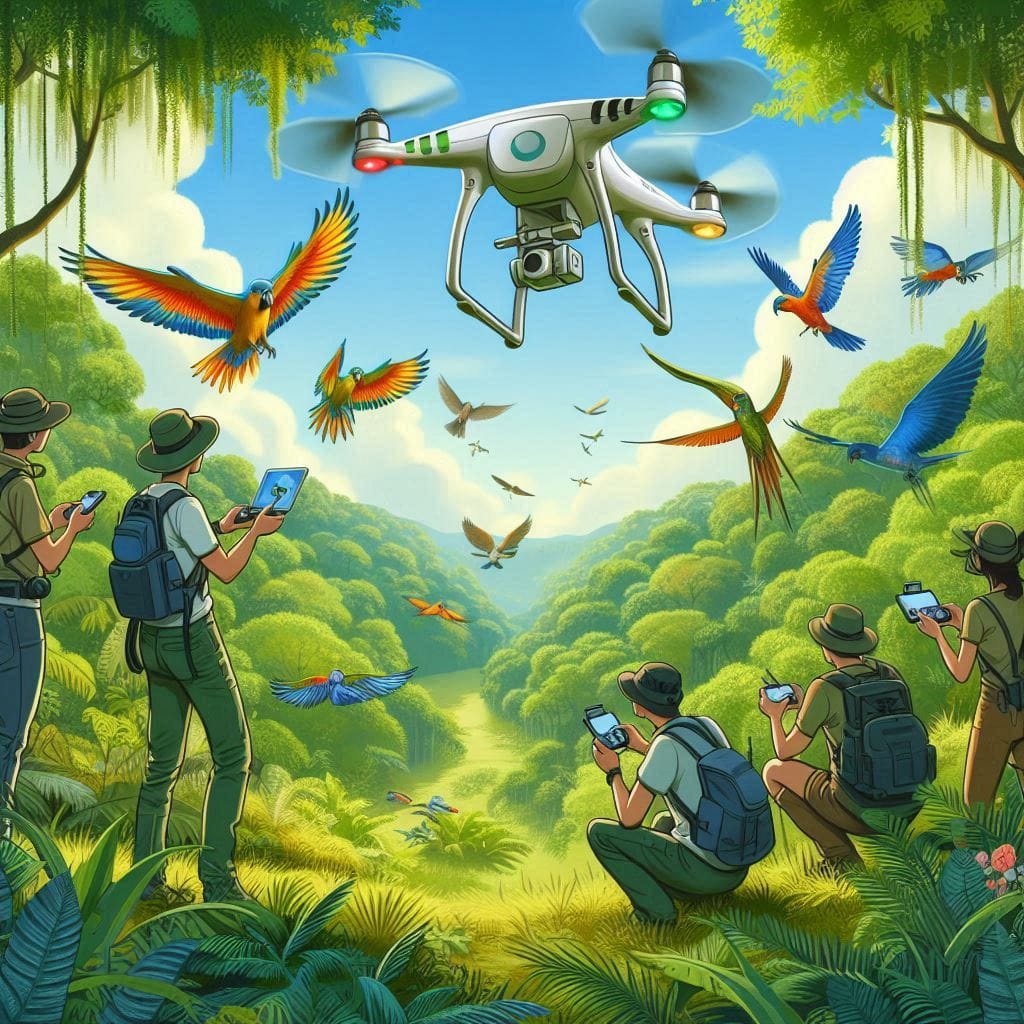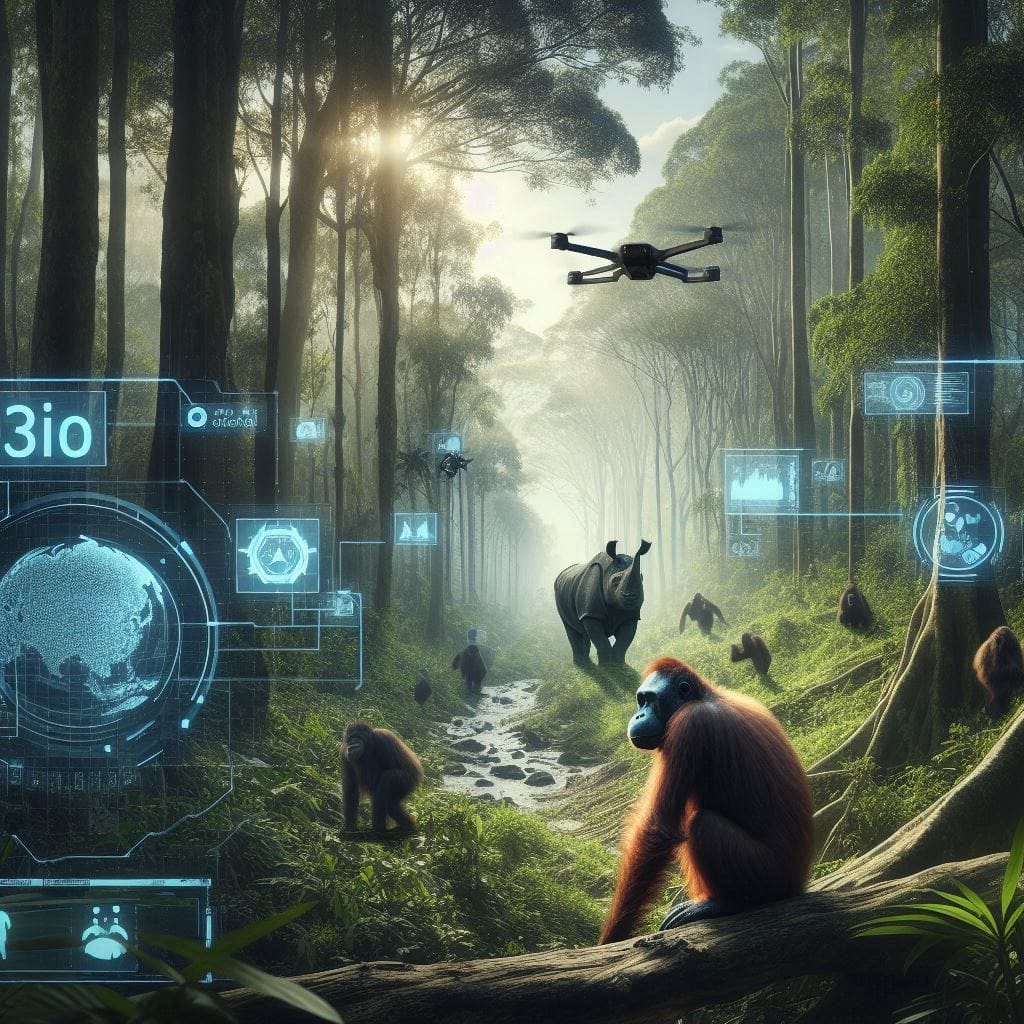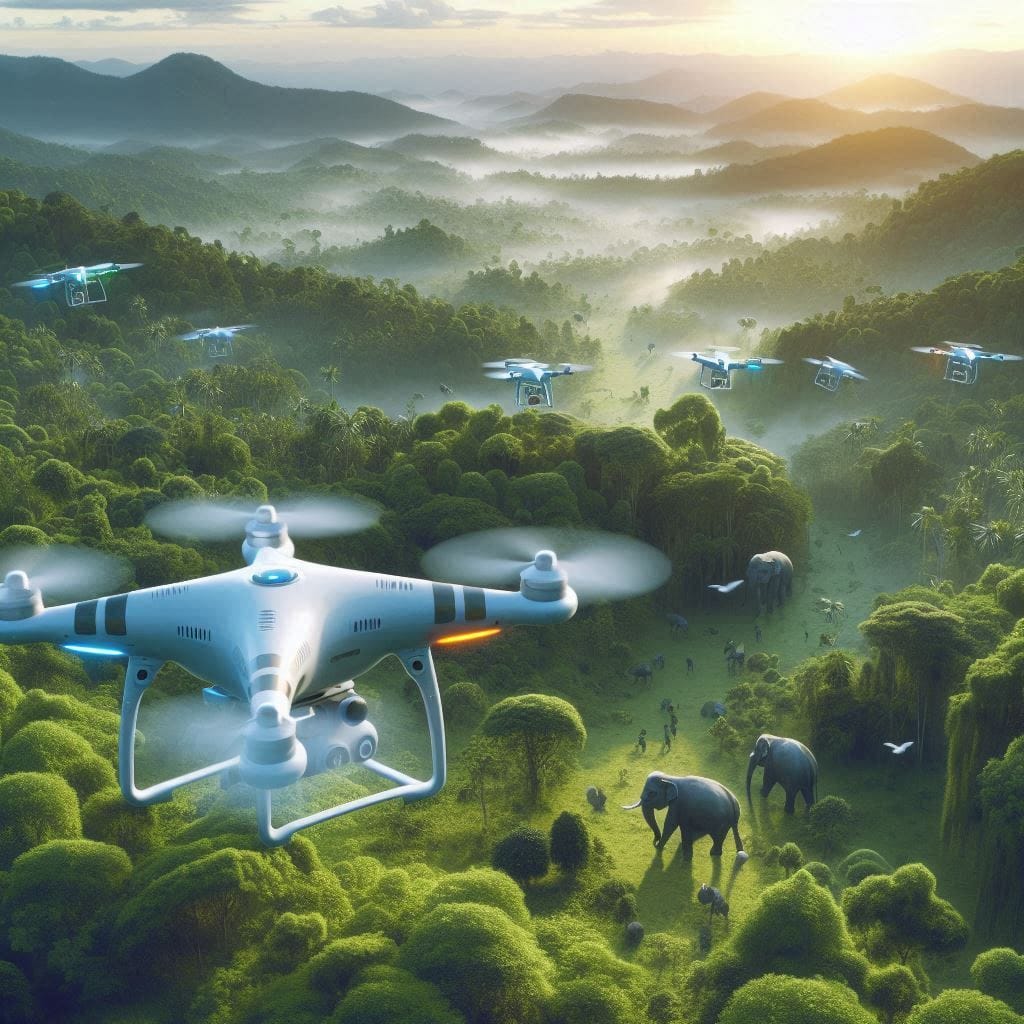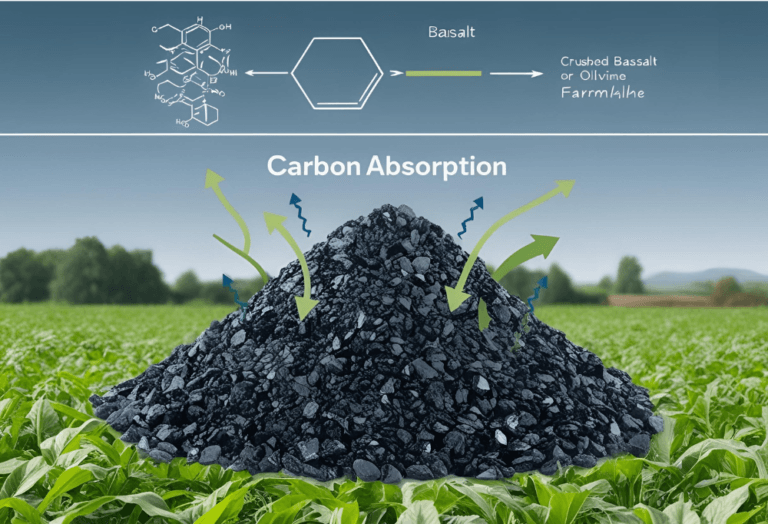Introduction to AI in Wildlife Conservation
As biodiversity continues to decline at an alarming rate—more than 1 million species are currently threatened with extinction—effective wildlife conservation has become a pressing global concern. The loss of biodiversity affects ecosystems, human health, and climate stability. In response to this crisis, innovative solutions are imperative. AI in wildlife conservation is emerging as a groundbreaking tool, harnessing technologies such as machine learning and computer vision to revolutionize conservation efforts.

For instance, conservation organizations are increasingly using AI to analyze data collected from various sources, allowing for better decision-making. This technology can process vast amounts of information quickly, enabling conservationists to identify trends and issues that may not be visible through traditional monitoring methods. The role of AI in wildlife conservation is not merely supplemental; it is becoming central to how we protect vulnerable species and their habitats.
The Role of AI in Wildlife Conservation
The applications of AI in wildlife conservation are extensive, providing powerful tools to address some of the most significant challenges facing conservationists today. These include species identification, population monitoring, and habitat analysis.
Species Identification and Tracking
One of the remarkable capabilities of AI in wildlife conservation is its ability to enhance species identification. Using machine learning algorithms, conservationists can analyze images and sounds collected from field cameras and audio sensors to distinguish between different species accurately. For example, researchers at Oxford University have developed a project called Wildlife Insights, which uses AI to process images captured in wildlife reserves. This initiative has shown a remarkable 90% accuracy rate in identifying species.
Such technology is invaluable for tracking endangered species like the Sumatran orangutan and black rhino, whose populations are critically low. With traditional methods often being labor-intensive and time-consuming, AI allows for rapid data collection and analysis, enabling conservationists to monitor populations more effectively. In 2021, AI-driven approaches resulted in the identification of over 60,000 individual animals in various protected areas, a significant improvement compared to previous methods.
Habitat Analysis and Climate Predictions
AI also plays a crucial role in habitat analysis and understanding the climate change impact on wildlife. For instance, researchers use AI to model potential habitat changes due to climate factors such as temperature and precipitation. A notable example is the Nature Conservancy, which employs AI to predict how changing climate conditions will affect marine and terrestrial habitats. Their models have provided critical insights into how species might adapt to these changes, allowing for better AI habitat conservation strategies.

Additionally, a study published in Nature revealed that AI could predict shifts in animal behavior in response to climate changes with an 83% accuracy rate. Such predictive modeling is vital for proactive conservation planning, ensuring that critical habitats remain viable for future generations.
AI in Poaching Prevention and Threat Detection
Poaching remains one of the gravest threats to wildlife conservation. AI in poaching prevention offers a transformative approach to combat this issue by utilizing real-time data and advanced surveillance techniques.
Real-Time Monitoring and Threat Detection
Innovative systems employing AI are being deployed across various national parks and wildlife reserves to enhance monitoring efforts. For example, the Black Mamba Anti-Poaching Unit in South Africa utilizes drones and AI wildlianalytics to monitor vast tracts of land, significantly improving their ability to respond to poaching threats. According to reports, these efforts have led to a 68% reduction in poaching incidents within their operational areas.
AI monitoring systems analyze data from various sensors, including camera traps and thermal imaging devices, to identify suspicious activities. When a potential poaching threat is detected, alerts are sent to rangers, enabling them to respond swiftly. This real-time capability enhances the efficiency of watching wildlife, making it possible to protect endangered species like elephants and rhinos effectively.
Case Study: The Success of AI in African Reserves
- The Pangolin Consortium has implemented AI technologies in several reserves to protect pangolins, the most trafficked mammals in the world. By using camera traps equipped with AI, they have successfully increased the identification and monitoring of pangolin populations.
- Drones equipped with AI technology have also been employed in various African reserves, including Serengeti National Park, to conduct aerial surveillance. This has led to not only a decrease in poaching incidents but also an increase in community involvement in conservation efforts, emphasizing the collaborative approach to wildlife protection.
Using AI for Ecosystem Health Monitoring
The health of ecosystems is crucial for maintaining biodiversity, regulating climate, and providing essential resources for human survival. AI wildlife technologies are increasingly being leveraged to analyze vast amounts of ecological data, such as vegetation cover, water quality, and species distribution, to assess the overall health of ecosystems. By integrating AI into ecosystem health monitoring, conservationists can gain wildlife insights that were previously unattainable.
- Real-Time Environmental Monitoring with AI-Powered Sensors AI-powered sensors are at the forefront of real-time environmental monitoring, providing instantaneous feedback on ecosystem conditions. For example, the World Wildlife Fund (WWF) has employed AI sensors in rainforests to monitor humidity, temperature, and soil moisture. This data is critical for understanding how climate change affects local ecosystems and can guide adaptive management strategies.
A significant advancement in this area is the use of drones equipped with AI technology to survey landscapes. Drones can collect high-resolution imagery, which AI algorithms analyze to assess vegetation cover and identify changes over time. According to a study by NASA, AI-assisted drone surveillance has enhanced forest health assessments by providing detailed maps that illustrate areas of concern, such as deforestation and habitat degradation.
- Applications in Predicting Forest Health and Responses to Conservation Efforts AI models can predict how ecosystems will respond to various conservation efforts, helping prioritize areas for protection. For example, researchers at the University of Cambridge developed an AI model that assesses how different conservation strategies might affect forest health over time. This predictive capability allows conservationists to allocate resources more effectively and focus on high-priority areas where interventions will yield the greatest impact.
Furthermore, AI can help identify early warning signs of ecosystem decline, such as reduced plant health or increased pollutant levels in water sources. By implementing AI systems for continuous monitoring, conservationists can take proactive measures to mitigate risks, ensuring that ecosystems remain resilient in the face of environmental changes.
Ethical Considerations and Challenges
As the use of AI in wildlife conservation grows, so do the ethical considerations surrounding its implementation. Addressing these ethical challenges is vital to ensure that technology supports conservation efforts without infringing on wildlife welfare or data integrity.
- Privacy Concerns and Data Biases One significant concern is the privacy of wildlife, particularly regarding the use of surveillance technologies to monitor animal movements. The deployment of cameras and sensors in natural habitats raises questions about how much monitoring is appropriate. While data collection can help protect endangered species, it must be balanced with the animals’ right to privacy.
Additionally, there is the potential for data biases in AI algorithms. If the training data used to develop AI models is skewed or unrepresentative, it may lead to inaccurate predictions and misinformed conservation strategies. For instance, an AI model trained primarily on data from one region may not effectively predict behaviors or health outcomes in different environments, which could jeopardize efforts in diverse ecosystems.
- Potential Overreliance on Technology Another challenge is the potential overreliance on technology. While AI offers powerful tools for conservation, it is essential to complement these technologies with traditional ecological knowledge and human expertise. Relying solely on AI could lead to a disconnect from the nuanced understanding that experienced conservationists bring to the field. This is especially true in complex ecosystems where human intuition and local knowledge play a crucial role in effective management.
Furthermore, there are concerns about the unintended environmental impacts of deploying certain AI technologies. For example, the use of drones for monitoring can disrupt local wildlife, particularly nesting birds. To mitigate such impacts, conservationists must ensure that AI technologies are implemented thoughtfully, with protocols in place to minimize harm.

The Future of AI in Wildlife Conservation
The future of AI in wildlife conservation holds immense potential, driven by emerging trends and technological advancements that can further refine conservation strategies. As AI technologies continue to evolve, their applications in biodiversity preservation are becoming increasingly sophisticated.
- Advancements in AI-Powered Predictive Models One promising development is the creation of more robust AI-powered predictive models that integrate various data sources, including satellite imagery, field observations, and climate data. These models are poised to provide deeper insights into species behavior, habitat health, and the impacts of environmental changes. For example, a collaborative project between Microsoft and the World Wildlife Fund aims to develop AI Wildlife tools that can predict the impact of deforestation on species migration patterns, enabling more effective conservation planning.
- Collaborations Between Conservationists and Tech Companies The future of wildlife conservation will likely see increased collaborations between conservationists and technology companies. By joining forces, these groups can harness the strengths of both sectors, combining ecological expertise with cutting-edge technology. Partnerships like the Wildlife Conservation Society’s collaboration with Google have already demonstrated the effectiveness of integrating AI solutions in monitoring wildlife populations in real time.
- Precise Conservation Strategies Ultimately, the ongoing advancements in AI will lead to more precise and adaptive conservation strategies, allowing for targeted interventions that can respond to dynamic environmental conditions. For instance, machine learning algorithms could analyze patterns in animal behavior to optimize habitat restoration efforts, ensuring that these interventions align with the needs of the species in question.
Conclusion
The integration of AI in wildlife conservation represents a transformative shift in how we approach the protection and management of our planet’s biodiversity. As we’ve explored throughout this post, the role of AI in wildlife conservation extends far beyond mere data analysis; it encompasses innovative solutions that address critical challenges such as habitat degradation, poaching, and ecosystem health monitoring.
By harnessing advanced technologies like machine learning and computer vision, conservationists are equipped to make more informed decisions that not only enhance our understanding of wildlife behavior but also improve the effectiveness of conservation efforts. AI-driven tools enable the watching wildlife in ways that were once unimaginable, from real-time monitoring of endangered species to predictive analytics that inform habitat management strategies.
However, the deployment of AI in this field is not without its challenges. Ethical considerations surrounding AI ethics in wildlife conservation, including data privacy and the potential biases in algorithms, must be addressed to ensure that these technologies serve both wildlife and the communities that depend on them. As we look to the future of AI in wildlife conservation, collaborations between conservationists and technology companies will be crucial in refining AI applications, leading to more precise and effective conservation strategies.
In summary, the potential of AI to revolutionize wildlife conservation is immense, paving the way for a more sustainable and resilient approach to protecting our planet’s precious ecosystems. As stakeholders in this global effort, it is essential for us to stay informed about these advancements and actively support initiatives that leverage technology for the greater good. Through ongoing innovation and ethical stewardship, we can hope to preserve the rich tapestry of life on Earth for future generations.
If you found this exploration of AI in wildlife conservation intriguing, make sure to check out some of our other insightful posts:
- Exploring Wave Energy Converters – Discover the technology behind wave energy converters and their potential to revolutionize renewable energy by harnessing the power of the ocean.
- Robotics in Agriculture – Dive into the innovative world of agricultural robotics. Learn how automation and precision technology are transforming farming practices for increased efficiency and sustainability.
- Augmented Reality in Healthcare – Explore the impact of augmented reality in the healthcare sector, from enhancing medical training to improving patient outcomes with immersive diagnostic tools.
- Artificial Rain 101 – Uncover the science behind artificial rain. Understand cloud seeding techniques and how artificial rain is helping to alleviate drought and support agricultural growth.
These topics cover some of the most exciting advances in science and technology. Don’t miss out on discovering how these innovations are shaping our world!






